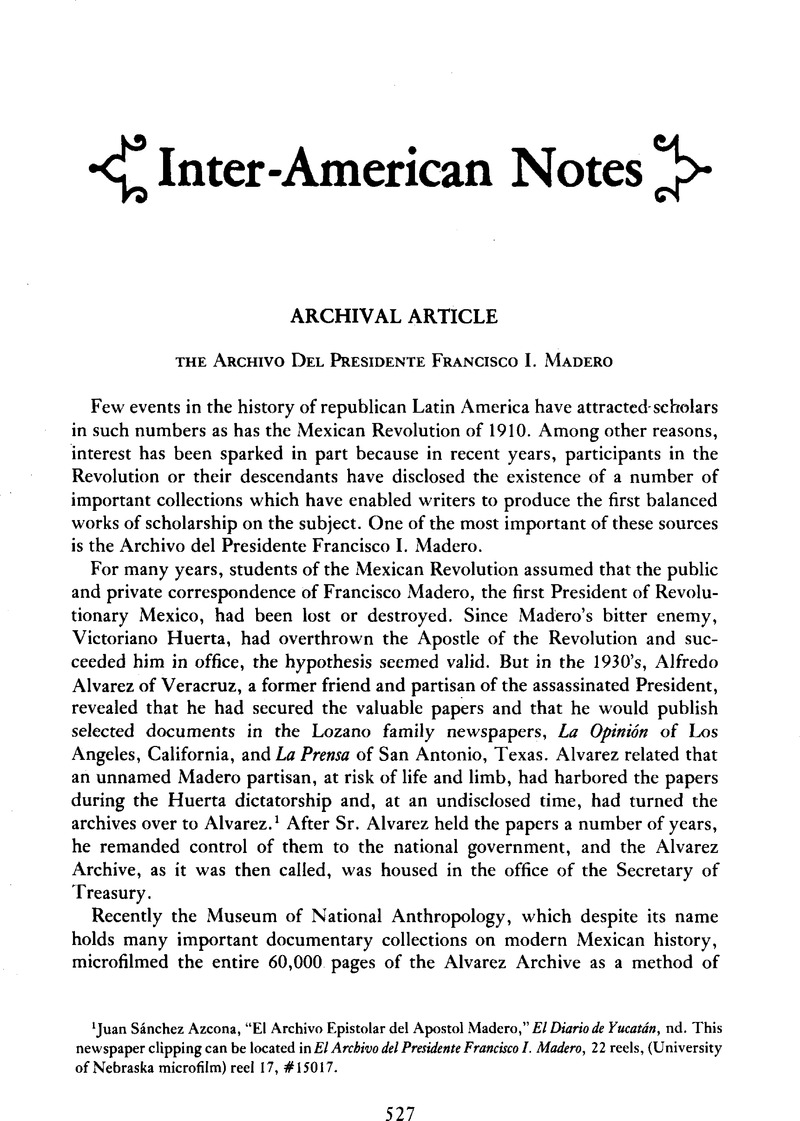No CrossRef data available.
Published online by Cambridge University Press: 11 December 2015

1 Azcona, Juan Sánchez, “El Archivo Epistolar del Apostol Madero,” El Diario de Yucatán, nd.Google Scholar This newspaper clipping can be located in El Archivo del Presidente Francisco I. Madero, 22 reels, (University of Nebraska microfilm) reel 17, #15017.
2 Ross, Stanley R., Francisco I. Madero: Apostle of Mexican Democracy, (New York: Columbia University Press, 1955) pp. vii-viii,Google Scholar states that he utilized the private collections of José C. Valadés and Félix F. Palavacini in addition to the Alvarez papers. Doubtless many other lesser collections exist throughout the Republic.
3 Valadés has incorporated these materials along with letters from the Alvarez archive, into his two volume study, Imaginación y Realidad de Francisco I. Madero, (Mexico: Antiguo Librería Robredo, 1960)
4 Azcona, Sánchez, “El Archivo Epistolar,” El Diario de Yucatán,Google Scholar in El Archivo del Presidente Francisco I. Madero, reel 17, #15017.
5 Beginning students may wish to consult Greenleaf, Richard E. and Meyer, Michael C., Research in Mexican History: Topics, Methodology, Sources, and a Practical Guide to Field Research, (Lincoln: University of Nebraska Press, 1973),Google Scholar especially pages 163–167.
6 See Charles Harris’s forthcoming volume on the Sánchez Navarro estates scheduled to be published by the University of Texas Press in the summer of 1975.
7 Several interesting dissertations in this general area have already appeared, see Lee, James H., “Porfirio Díaz and the Mexican Minister of the Interior 1876–1911: A Case Study of the Porfirian Power Structure,” (unpublished PhD dissertation, Ohio State University),Google Scholar Bryan, Anthony T., “Mexican Politics in Transition: 1900–1913: The Role of General Bernardo Reyes,” (unpublished PhD dissertation, University of Nebraska),Google Scholar and Schmitz, Martin T., “Origins of the Mexican Revolution of 1910 in the State of Chihuahua,” (PhD dissertation in progress, University of New Mexico.)Google Scholar
8 The fallacy of depending on this single source for all information, however, was clearly shown by Knudsen, Jerry W., “When Did Francisco I. Madero Decide on Revolution?” The Americas, 30, (April, 1974) pp. 529–534.CrossRefGoogle Scholar Knudsen encountered a letter in the aforementioned Biblioteca Nacional collection which indicated that Madero intended to revolt almost from the outset of the political campaign of 1910, a view which conflicts with Ross, , Madero, p. 63,Google Scholar and Cumberland, Charles C., The Mexican Revolution: Genesis under Madero, (Austin: University of Texas Press, 1952), p. 117.Google Scholar
9 Ross, , Madero, pp. 50–57.Google Scholar
10 Womack, John Jr. used some of this material in his Zapata and the Mexican Revolution, (New York: Random House, 1968) pp. 97–121.Google Scholar In his bibliography, however, Womack suggests that only a limited amount of pertinent material can be gleaned from the Madero collection, see p. 415.
11 Several studies have uncovered evidence of fraud in the gubernatorial elections of 1911. See Meyer, Michael C., Mexican Rebel: Pascual Orozco and the Mexican Revolution: 1910–1915, (Lincoln: University of Nebraska Press, 1967) pp. 39–41,Google Scholar and Beezley, William H., Insurgent Governor: Abraham González and the Mexican Revolution in Chihuahua, (Lincoln: University of Nebraska Press, 1973) pp. 75–82.Google Scholar My own dissertation, entitled “Counterrevolution in Mexico: Félix Díaz and the Struggle for National Supremacy: 1910–1920,” (Unpublished PhD dissertation, University of Nebraska, 1973) pp. 72–77, shows a similar pattern of events in Oaxaca.